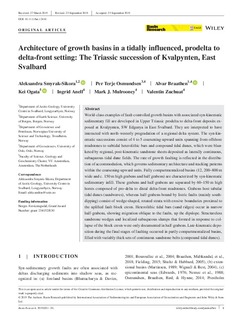| dc.contributor.author | Smyrak-Sikora, Aleksandra | |
| dc.contributor.author | Osmundsen, Per Terje | |
| dc.contributor.author | Braathen, Alvar | |
| dc.contributor.author | Ogata, Kei | |
| dc.contributor.author | Anell, Ingrid Margareta | |
| dc.contributor.author | Mulrooney, Mark Joseph | |
| dc.contributor.author | Zuchuat, Valentin | |
| dc.date.accessioned | 2020-02-13T10:22:23Z | |
| dc.date.available | 2020-02-13T10:22:23Z | |
| dc.date.created | 2019-12-19T09:05:01Z | |
| dc.date.issued | 2019 | |
| dc.identifier.citation | Basin Research. 2019, . | nb_NO |
| dc.identifier.issn | 0950-091X | |
| dc.identifier.uri | http://hdl.handle.net/11250/2641496 | |
| dc.description.abstract | World‐class examples of fault‐controlled growth basins with associated syn‐kinematic sedimentary fill are developed in Upper Triassic prodelta to delta‐front deposits exposed at Kvalpynten, SW Edgeøya in East Svalbard. They are interpreted to have interacted with north‐westerly progradation of a regional delta system. The syn‐kinematic successions consist of 4 to 5 coarsening‐upward units spanning from offshore mudstones to subtidal heterolithic bars and compound tidal dunes, which were blanketed by regional, post‐kinematic sandstone sheets deposited as laterally continuous, subaqueous tidal dune fields. The rate of growth faulting is reflected in the distribution of accommodation, which governs sedimentary architecture and stacking patterns within the coarsening‐upward units. Fully compartmentalized basins (12, 200–800 m wide and c. 150 m high grabens and half grabens) are characterized by syn‐kinematic sedimentary infill. These grabens and half‐grabens are separated by 60–150 m high horsts composed of pro‐delta to distal delta‐front mudstones. Grabens host tabular tidal dunes (sandwaves), whereas half‐grabens bound by listric faults (mainly south‐dipping) consist of wedge‐shaped, rotated strata with erosive boundaries proximal to the uplifted fault block crests. Heterolithic tidal bars (sand ridges) occur in narrow half‐grabens, showing migration oblique to the faults, up the dipslope. Structureless sandstone wedges and localized subaqueous slumps that formed in response to collapse of the block crests were only documented in half‐grabens. Late‐kinematic deposition during the final stages of faulting occurred in partly compartmentalized basins, filled with variably thick sets of continuous sandstone belts (compound tidal dunes). | nb_NO |
| dc.language.iso | eng | nb_NO |
| dc.publisher | Wiley | nb_NO |
| dc.rights | Navngivelse 4.0 Internasjonal | * |
| dc.rights.uri | http://creativecommons.org/licenses/by/4.0/deed.no | * |
| dc.title | Architecture of growth basins in a tidally influenced, prodelta to delta-front setting: The Triassic succession of Kvalpynten, East Svalbard | nb_NO |
| dc.type | Journal article | nb_NO |
| dc.type | Peer reviewed | nb_NO |
| dc.description.version | publishedVersion | nb_NO |
| dc.source.pagenumber | 30 | nb_NO |
| dc.source.journal | Basin Research | nb_NO |
| dc.identifier.doi | 10.1111/bre.12410 | |
| dc.identifier.cristin | 1762812 | |
| dc.relation.project | Norges forskningsråd: 234152 | nb_NO |
| dc.description.localcode | © 2019 The Authors. Basin Research published by International Association of Sedimentologists and European Association of Geoscientists and Engineers and John Wiley & Sons Ltd. This is an open access article under the terms of the Creative Commons Attribution License, which permits use, distribution and reproduction in any medium, provided the original work is properly cited. | nb_NO |
| cristin.unitcode | 194,64,90,0 | |
| cristin.unitname | Institutt for geovitenskap og petroleum | |
| cristin.ispublished | true | |
| cristin.fulltext | original | |
| cristin.qualitycode | 2 | |

